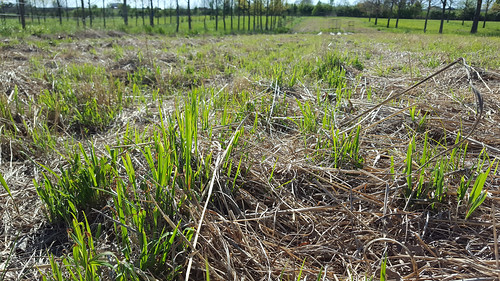Native warm season grasses a good dry-season forage option, but require planning to use
May 18, 2018
By Sarah Cato
U of A System Division of Agriculture
Fast facts:
- Native warm season grasses are a great forage option for dry summer months
- Provide many benefits
- Location and stocking rates should be kept in mind
(590 words)
(Newsrooms – with downloadable art here: https://flic.kr/p/26aaoDq )
Download Word version
LITTLE ROCK – Some ranchers seeking solutions for dry-season forage production are
turning to native warm season grasses, but using these grasses takes careful planning.
Dirk Philipp, associate professor of forages for the University of Arkansas System Division of Agriculture, said one of these considerations is the period of time the grasses will be grazed. Grazing periods should be monitored and controlled when using native warm season grasses.

“Because of their narrow growth curve and a growing point that is located relatively high above the surface, especially as grasses mature, grazing should take place only between mid-May and end of August,” he said. “Grazing is not recommended after Sept. 1, as the grasses need to accumulate carbohydrate reserves that bring them through the winter.”
Philipp added to keep in mind the species of grass when determining grazing periods.
“Some species like switchgrass become stemmy during the summer,” he said, “that narrows down possible grazing times even further.”
These grazing period restrictions could also limit the number of grazing cycles.
“Depending on the year and setup, there may be only two grazing cycles overall, as the time for regrowth is lacking and because native warm season grasses should not be grazed in the fall shortly before the first frost,” Philipp said.
Long-term planning needed
Long-term planning is important for those wishing to use native grasses for grazing.
“Have a long-term plan in mind where native warm season grasses will be located on the farm, as grazing will be during specific times only which in turn determines the location of water access points, travel lanes and more,” Philipp said.
“Put these grasses where you can reap the benefits of their versatility in providing grazing, protection from erosion and a better wildlife habitat than your commonly used forages such as Bermudagrass and tall fescue,” he added.
Again, the species of grass will play a role in choosing the ideal location.
“Big bluestems and Indiangrass work better on drier sites with good drainage,” Philipp said, “while switchgrass also works in wetter locations with heavier soils.”
Consider stocking rates
Stocking rates are another factor producers should keep in mind.
“Stock native warm season grasses once they reach at least 8-12 inches, as this provides enough leaf material to be grazed,” said Philipp. “The time of year plants reach this height varies, so canopy heights should be checked in the field.”
“Schedule and calculate stocking rate and densities so that the leafy growth is grazed relatively quickly, while not letting animals go back repeatedly to the same grazing spots,” Philipp said. “This will help to avoid grazing too deep into the canopy and potentially damaging or biting off growing points. Leave at least four inches or canopy height when leaving the paddock.”
Removal of old and dead plant matter is another consideration for these grasses.
“Native warm season grasses develop a heavy thatch over time. Although burning is not required to keep the stand alive, old and dead plant material is best removed via burning,” Philipp said. “If you plan on burning, make sure you can safely do so.”
For more information about forages, contact your county extension office or visit www.uaex.uada.edu.
About the University of Arkansas System Division of AgriculturThe University of Arkansas System Division of Agriculture’s mission is to strengthen agriculture, communities, and families by connecting trusted research to the adoption of best practices. Through the Agricultural Experiment Station and the Cooperative Extension Service, the Division of Agriculture conducts research and extension work within the nation’s historic land grant education system.
The Division of Agriculture is one of 20 entities within the University of Arkansas System. It has offices in all 75 counties in Arkansas and faculty on five system campuses.
Pursuant to 7 CFR § 15.3, the University of Arkansas System Division of Agriculture offers all its Extension and Research programs and services (including employment) without regard to race, color, sex, national origin, religion, age, disability, marital or veteran status, genetic information, sexual preference, pregnancy or any other legally protected status, and is an equal opportunity institution.
# # #
Media Contact: Mary Hightower
Dir. of Communication Services
U of A System Division of Agriculture
Cooperative Extension Service
(501) 671-2126
mhightower@uada.edu